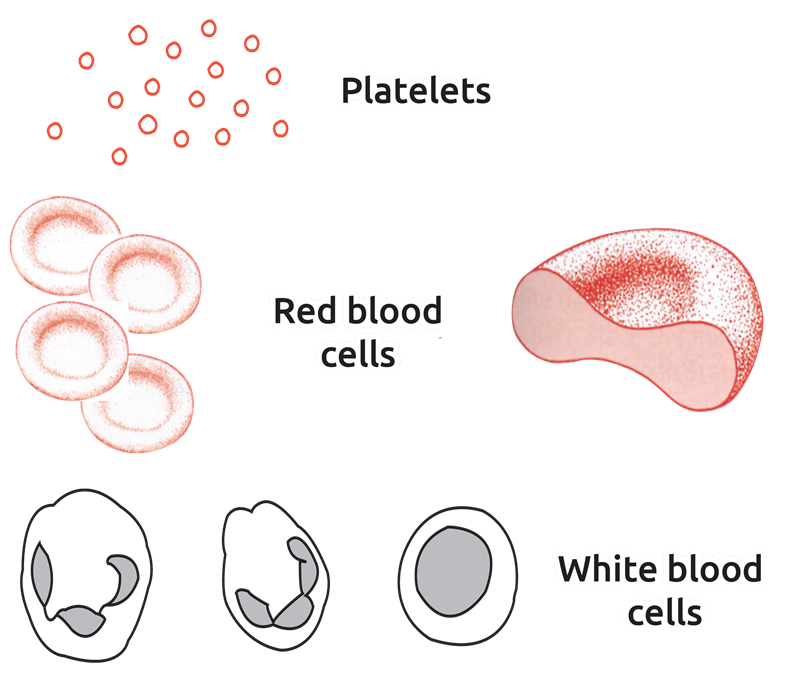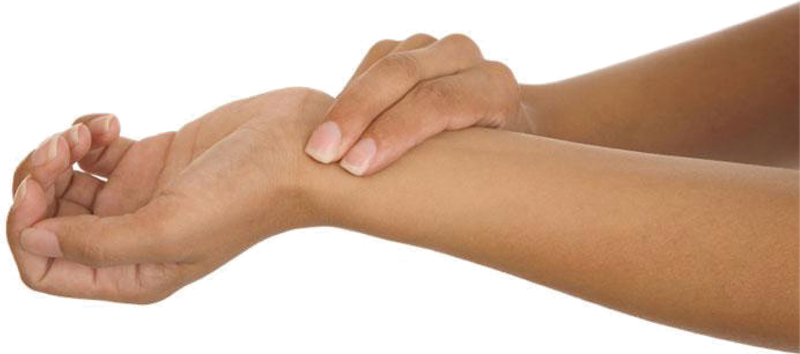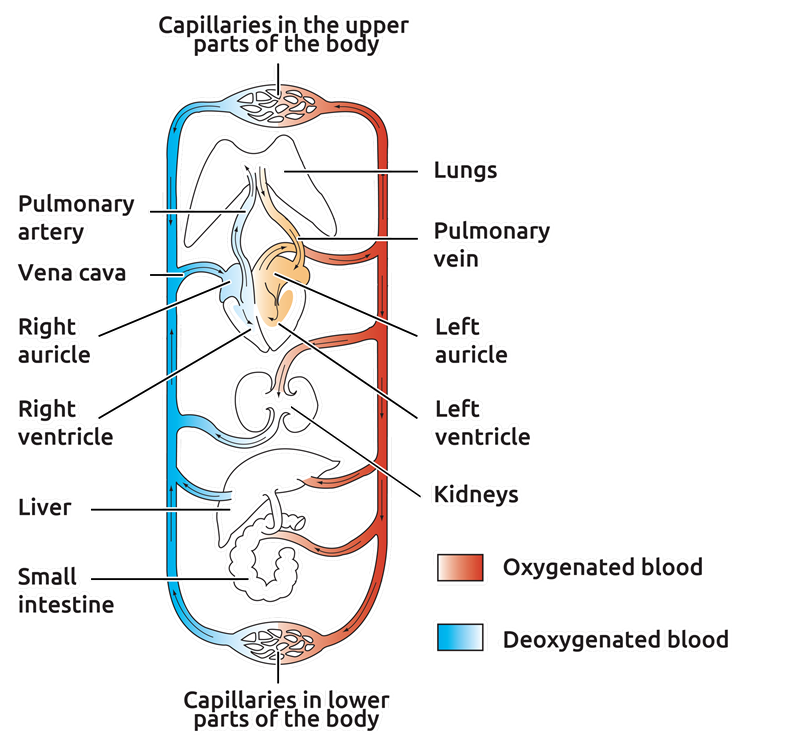Introduction
You have already studied some human body systems. In Standard Five, you learnt about the breathing and digestive systems. In Standard Six, you learnt about the reproductive system. In this class, you will study the circulatory system.
The Blood Circulatory System
The blood is a very important liquid in the life of animals. It is a transport fluid for the body. Blood flows from the heart to all parts of the body, and then back to the heart. It flows through the blood vessels. This flow of blood from the heart to the body organs and back to the heart is called blood circulation. The organs that are involved in the circulation make up the circulatory system.
When circulating round the body, the blood carries with it various substances required in different body parts. It also removes waste products from different parts of the body to the organs that remove these products safely
The parts of the circulatory system
The blood circulatory system in human beings and animals is composed of a pump (the heart), a fluid (blood) and a network of tubes (the blood vessels).
- The heart: This is a muscular organ that pumps blood to all parts of the body.
- The blood: This is the transport fl uid for the body.
- The blood vessels: The blood in our bodies circulates around the body in the blood vessels of various kinds. These vessels are in the form of tubes of various sizes. These range from the small vessels called capillaries to the large ones known as veins and arteries.
The other support organs in the blood circulatory system are the lungs.
Blood Components and their Functions
The blood is a body fluid. The four main components of the blood are:
- Plasma
- Red blood cells
- White blood cells
- Platelets

Plasma
This is the main part of blood. It is the liquid part, which is mostly water.
Digested food materials, salts and other dissolved substances are found within the plasma.
Red blood cells
These are smaller than the white blood cells. They help to carry oxygen from the lungs to the body organs. The red blood cells are very many in the blood. They contain a red colouring matter called haemoglobin, which gives the blood its red colour. Haemoglobin combines quickly with oxygen to form a chemical substance known as oxyhaemoglobin.
Blood that contains a lot of haemoglobin is called oxygenated blood. It is scarlet or bright red in colour. Once the oxygenated blood passes through the body organs, it gives out the oxygen and gets carbon dioxide. Blood that has lost oxygen to the body organs is called deoxygenated blood and is dull red in colour.
White blood cells
White blood cells are larger than the red blood cells. They are, however, fewer in number than the red blood cells. White blood cells help to fi ght and kill disease-causing germs.
Platelets
Have you ever hurt yourself? Did you bleed for a long time or did the bleeding stop after sometime?
After we hurt ourselves, bleeding stops after a short time. This is because there are cells in the blood called platelets. They help to clot blood when we are injured. The clotting prevents further loss of blood from the wound.
Work to Do
- Explain the following terms:
- Blood circulation
- Circulatory system
- Heart
- Blood
- Blood vessels
- Plasma
- Haemoglobin
- Blood platelets
- Plasma
- Clotting
- Explain the difference between:
- Oxygenated and deoxygenated blood
- White and red blood cells
Types of Blood Vessels and Their Functions
Blood vessels are the tubes through which blood flows. The main blood vessels are:
- Arteries
- Veins
- Capillaries
The blood vessels transport the blood to all parts of the body and back to the heart. The arrangement of blood vessels in the body can be compared to theroad network in a country.
To travel to a place by road, you may have to take a large highway, then get into a small tarmac road, then take an avenue, then a street and finally a dirt road. To go back home, it might be the reverse of the journey. You may have to start with the dirt road and finally take the highway. You may, however, decide to use other roads to avoid traffic jam.
In the circulatory system, large blood vessels called arteries leave the heart. They branch into smaller arteries and finally into the smallest blood vessels called capillaries. During the return journey to the heart, the blood flows through the veins.
- Arteries carry blood from the heart to different parts of the body. The main artery is the aorta.
- Veins carry blood from different parts of the body to the heart. The main vein is the vena cava.
- All arteries carry blood rich in oxygen (oxygenated blood) except the pulmonary artery, which carries deoxygenated blood from the heart to lungs.
- All veins carry deoxygenated blood except the pulmonary vein, which carries oxygenated blood from the lungs to heart.
Arteries
- They carry blood away from the heart to other parts of the body.
- They have thick walls and are narrower than the veins.
- They have no valves since they carry blood that is at a high pressure from the heart.
The movement of blood in an artery is in ‘waves’. The ‘waves’ can be felt as pulse as the heart pumps the blood to the body organs. The number of the ‘waves’ that can be felt in a minute is called the pulse rate. The pulse can be felt on the inside of the wrist.
Activity 1: Counting the number of heartbeats
Procedure
- Place the palm of your hand firmly on the left side of your chest. What do you feel?
The beats you have felt are made by the heart when pumping blood to all parts of the body. - Count the number of beats per minute.
- Now go outside and run a 100-metre stretch.
- Count the number of heartbeats again. Does running make any difference in the number of heartbeats?
Observation
Running makes the heart to beat faster. This increases the number of heartbeats per minute. The body tissues need more supply of oxygen when one is running. The heart beats faster so as to increase the rate of blood supply
Activity 2: Checking the pulse on the wrist
Place your fingers on the wrist of another pupil as shown below:
Procedure
- Count the number of heartbeats in a minute.
- Let the pupil go outside and run a distance of 100 metres.
- Count the number of heartbeats again.
- Do the number of heartbeats change after running? Do they increase or decrease?
- Record your findings.
Observation
The heartbeat is also called pulse. The average number of heartbeats of a normal person at rest is about 70 to 75 beats per minute. The number of heartbeats increases during an activity or when someone is sick. This is why doctors check the heartbeat (pulse) of a patient.

Veins
- They carry blood from the other parts of the body to the heart.
- They have thinner walls than the arteries, but they are wider.
- They have valves which prevent the blood from flowing backwards. Blood in the veins flows at a low pressure.
Capillaries
Look at the white part of another pupil’s eye. Can you see some small blood vessels? These small blood vessels that help to take blood to all parts of the body are called capillaries. They cover a wide surface of the body.
Work to Do
- Observe your arms and the back of your hand. Clench your fist and observe again. Do you see any dark lines at the surface of the skin? These are veins.
- Observe a piece of meat being chopped. Look for:
- Blood oozing from the meat tissue.
- Any tiny blood vessels from which the blood is oozing.
- Blood that has clotted; that is, blood that has solidified to form lumps.
Discuss your observations with your classmates.
- Name the types of blood vessels found in the circulatory system.
Structure and Functions of the Heart
The heart is a muscular organ that pumps the blood to all parts of the body. Study the diagram of a mammalian heart shown in figure 1.3.

The heart is made up of four chambers. Two chambers are on the upper side and are called auricles. There is the right auricle (RA) and the left auricle (LA). Two other chambers are on the lower side and are called ventricles. There is the right ventricle (RV) and the left ventricle (LV).
The heart chambers have valves. These valves prevent the blood from flowing backwards.
Auricles have thin walls while ventricles have thick walls. Ventricles are, therefore, more muscular than the auricles. Auricles collect blood coming from the body organs flowing through the major veins. They then empty it into the ventricles. The thick muscles of the right and left ventricles pump the blood to the body parts. The wall of the left ventricle is thicker than the wall of the right ventricle. This is because the left ventricle pumps blood to all the body organs; the right ventricle pumps blood to the lungs only.
Work to Do
- Visit a butchery and fi nd out the following:
How many chambers is a heart of a mammal such as a goat or a cow divided into? Record your observations. - Draw the mammalian heart and label its various parts.
The Circulation of Blood
The heart pumps the blood to all parts of the body. The blood leaves the heart and flows to the body parts through the arteries. The blood returns to the heart from the body parts through the veins. The steps involved in the circulation are as follows:
- Blood from all parts of the body flows into the right auricle (RA) of the heart through the vena cava. This blood is deoxygenated as the parts of the body have already used up the oxygen; it also contains carbon dioxide collected from the body organs. This blood then passes from the right auricle into the right ventricle through a valve.
- The muscular right ventricle then pumps this blood into the lungs through the pulmonary artery.
- In the lungs, oxygen is added to the blood and carbon dioxide is removed. The carbon dioxide is then breathed out.
- The oxygenated blood flows to the left auricle of the heart through the pulmonary vein. The left auricle then pumps the oxygenated blood down into the left ventricle through a valve.
- The muscular left ventricle then pumps the blood to all parts of the body through the aorta. Once the blood circulates to all parts of the body, it flows back to the heart and the cycle begins once more.

Veins have valves whereas arteries do not. The valves in the veins stop the blood from flowing backwards.
The blood in the arteries flows under high pressure because of the heart pumping action. The blood in the arteries, therefore, does not flow backwards because of the heart’s pumping pressure.
Work to Do
1. Complete the table below:
Blood vessel | Function |
Vena cava | Carries blood from to |
Pulmonary artery | Carries blood from to |
Pulmonary vein | Carries blood from to |
Aorta | Carries blood from to |
2. Which blood vessels carry blood away from the heart?
3. Which blood vessels carry blood from other parts of the body back to the heart?
4. The tiniest blood vessels are the .
The Importance of Blood Circulation
Blood has many functions in the body as you may have noted earlier on. One of the functions is transport. Blood is the main transport fluid in the body. It transports the following:
- Digested foods from the small intestine to all parts of the body.
- Oxygen from the lungs to all cells of the body.
- Carbon dioxide from the body tissues to the lungs.
- Waste material like urea to the kidneys. Urea is passed out of the body as urine.
- Heat to all parts of the body.
The white blood cells in the blood protect the body by fighting against germs and diseases.
Blood also carries hormones from where they are produced to where they are needed in the body.
Important Information
HIV can be transmitted through blood
Blood is one of the body fluids through which the HIV is transmitted. Blood can be exchanged through:
- Blood transfusion: Blood donated to hospitals is always checked for the presence of the HIV. Any infected blood is rejected.
- Open wounds: Always cover open wounds. Never touch blood from another person without wearing protective clothing such as gloves.
- Sharing unsterilised skin-cutting and piercing instruments.
Caution: Do not share needles, scissors, tweezers, razor blades and syringes.
If you have to share, always ensure that they are sterilised.
Unit Summary and Important Terms
- The flow of blood from the heart to the body organs and back to the heart is called blood circulation.
- The organs that are involved in the circulation make up the circulatory system.
- The blood circulatory system in human beings and animals is composed of the heart, the blood and the blood vessels.
- The four main components of the blood are plasma, red blood cells, white blood cells and platelets.
- Platelets help to clot blood. White blood cells help to fight and kill disease-causing germs.
- The red blood cells contain a red colouring matter called haemoglobin, which gives the blood its bright red colour.
- Haemoglobin combines quickly with oxygen to form a chemical substance known as oxyhaemoglobin.
- Blood that contains a lot of haemoglobin is called oxygenated blood. It is scarlet or bright red in colour.
- Blood that has lost oxygen to the body organs is called deoxygenated blood. It is dull red in colour.
- The main blood vessels are arteries, veins and capillaries. Arteries carry blood from the heart to different parts of the body. The main artery is the aorta.
- Veins carry blood from different parts of the body to the heart. The main vein is the vena cava.
- All arteries carry blood rich in oxygen (oxygenated blood) except the pulmonary artery, which carries deoxygenated blood from the heart to lungs.
- All veins carry deoxygenated blood except the pulmonary vein, which carries oxygenated blood from lungs to heart.
- The valves in the veins and the heart stop the blood from fl owing backwards.
- The heart is a muscular organ that pumps the blood to all parts of the body.
- The heart is made up of four chambers: the right auricle (RA), the left auricle (LA), the right ventricle (RV) and the left ventricle (LV).
